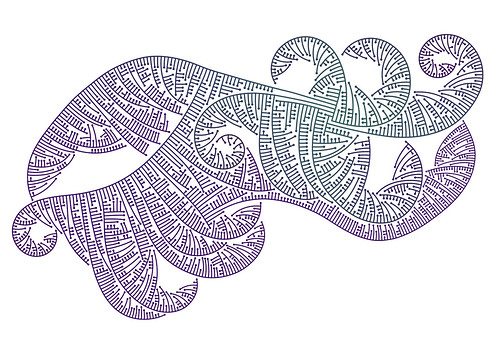A new generative work that has just fallen into place; I'll be showing prints at the upcoming Dorkbot CBR show (CCAS Manuka, in November). Made with Processing. More will accumulate here.
Economic growth is a central tenet of contemporary capitalism; but the logic of endless growth seems increasingly difficult to sustain. Limits to Growth, published in 1972 (the year I was born), was commissioned by the Club of Rome to report on the economic implications of exponential growth, and used an abstract "world model" to predict the behaviour of the global economic system. This artwork experiments with growth in another model world: a simple generative system in the form of a computer program. In this two-dimensional system, growth has the ability to constrain itself, creating boundaries that define a formal and graphical whole. These forms are utopian diagrams of self-limiting growth.
Monday, September 22, 2008
Limits to Growth
Posted by Mitchell at 4:33 pm
Labels: generative art, growth, processing, projects


9 comments:
Nice. I'm thinking neo-tribal algorithmic body art: walk into a booth, pinprick a drop of blood, DNA sample used as a generative seed, inscribed on your skin by a robot tattooist. Meet someone and compare your tattoos to work out your genetic relationship.
these are beautiful. they look like subdivision plans, not sure if it was intended, but very applicable to the subject of limits and growth.
@michael sounds like Bruce Sterling cyberpunk! The generative system has only a few parameters, but the random curature biasing has a huge impact. So maybe the DNA could be the random number generator seed?
@hebchop thanks a lot; yes the suburban image was intended from the start but came about by happy accident (as usual). Glad you caught it.
I wonder what happens to those pixels who find themselves born at the limits but are not allowed to procreate?
Are they happy with their lot in life?
Wonderful fresh work Mitchell. I like the variation amongst the set, but particularly the subtle use of colour. Have you looked at Edward Tufte's research?
Is this modeled off a particular growth algorithm, or one of your own creation?
Thanks Benjamin. I am aware of Tufte in general, but not in detail - I did have a dig at his Wavefields in a paper recently.
The algorithm started as a simple Eden growth/aggregation model. It's been highly modified though, so it consider it semi-original. You could probably represent the same structure with an L-system - it's the recursive application of a (partly stochastic) rule to a set of elements.
Were you involved in this at all?
Uncanny coincidence, they mention "city growth and expansion" as inspiration as well.
You get extra points for using Processing over Scriptographer IMHO:)
hey hebchop, no I wasn't aware of that Jonathan Puckey work. It's nice, but software augmented human drawing, rather than generative forms, right? Thanks for the link.
Great work, Mitchell. The forms are very captivating and not at all typical of the type of aesthetic that tends to come out of growth systems.
Post a Comment